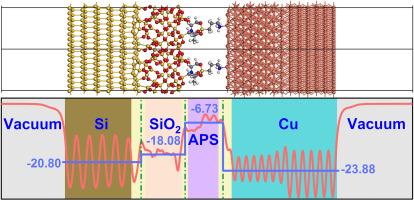用自组装单层1-(3-氨基丙基)硅烷作为扩散阻挡层提高铜互连可靠性的计算研究
IF 4.6
3区 工程技术
Q2 ENGINEERING, ELECTRICAL & ELECTRONIC
引用次数: 0
摘要
随着集成电路技术向更小尺寸和更高性能的方向发展,铜互连扩散问题已成为限制其可靠性的关键因素。为了提高铜互连的可靠性,本研究重点研究了一种新型扩散屏障材料——自组装单层(SAM) 1-(3-氨基丙基)硅氮烷(APS)。通过密度泛函理论计算和分子动力学模拟相结合,深入研究了APS在SiO2表面的吸附行为、SAM的形成机理以及Si/SiO2/SAM-APS/Cu界面的微观结构和性能。研究表明,APS分子通过氨基与SiO2表面形成强烈的化学相互作用,并能稳定地在SiO2表面组装成单层,表现出明显的扩散屏障效应。特别是在高温条件下,SAM-APS层保持了优异的热稳定性和强大的扩散屏障能力。此外,APS - SAM结构在界面处诱导出明显的能带结构,有效地抑制了电子和金属离子的扩散,增强了界面的稳定性。模拟结果表明,SAM-APS层在SiO2/Cu界面处达到了超过11.35 eV的扩散势垒高度,突出了其优异的应用潜力。本研究为铜互连技术中扩散阻挡层的设计引入了新的概念,为高性能、高可靠性微电子器件的发展提供了科学基础。未来的研究重点将是进一步优化SAM-APS的性能,探索其在更复杂的微电子系统中的应用潜力。本文章由计算机程序翻译,如有差异,请以英文原文为准。

Enhancing copper interconnect reliability with self-assembled monolayer 1-(3-Aminopropyl)silatrane as diffusion barrier layer: A computational study
With the advancement of integrated circuit technology towards smaller dimensions and higher performance, the issue of copper interconnect diffusion has emerged as a critical factor limiting their reliability. To enhance the reliability of copper interconnects, this study focuses on the innovative diffusion barrier material, self-assembled monolayer (SAM) 1-(3-aminopropyl)silazane (APS). By integrating density functional theory calculations with molecular dynamics simulations, an in-depth investigation is conducted into the adsorption behavior of APS on the SiO2 surface, the formation mechanism of SAM, and the microstructure and properties of the Si/SiO2/SAM-APS/Cu interface. The research demonstrates that APS molecules form strong chemical interactions with the SiO2 surface via amino groups and can stably assemble into a monolayer on the SiO2 surface, exhibiting a significant diffusion barrier effect. Particularly under high-temperature conditions, the SAM-APS layer maintains excellent thermal stability and a robust diffusion barrier capacity. Furthermore, the APS SAM configuration induces a distinct band structure at the interface, effectively inhibiting the diffusion of electrons and metal ions and enhancing the stability of the interface. Simulation results indicate that the SAM-APS layer achieves a diffusion barrier height exceeding 11.35 eV at the SiO2/Cu interface, highlighting its exceptional application potential. This study introduces novel concepts for the design of diffusion barrier layers in copper interconnect technology and provides a scientific foundation for the development of high-performance and high-reliability microelectronic devices. Future research will focus on further optimizing the performance of SAM-APS and exploring its application potential in more complex microelectronic systems.
求助全文
通过发布文献求助,成功后即可免费获取论文全文。
去求助
来源期刊

Materials Science in Semiconductor Processing
工程技术-材料科学:综合
CiteScore
8.00
自引率
4.90%
发文量
780
审稿时长
42 days
期刊介绍:
Materials Science in Semiconductor Processing provides a unique forum for the discussion of novel processing, applications and theoretical studies of functional materials and devices for (opto)electronics, sensors, detectors, biotechnology and green energy.
Each issue will aim to provide a snapshot of current insights, new achievements, breakthroughs and future trends in such diverse fields as microelectronics, energy conversion and storage, communications, biotechnology, (photo)catalysis, nano- and thin-film technology, hybrid and composite materials, chemical processing, vapor-phase deposition, device fabrication, and modelling, which are the backbone of advanced semiconductor processing and applications.
Coverage will include: advanced lithography for submicron devices; etching and related topics; ion implantation; damage evolution and related issues; plasma and thermal CVD; rapid thermal processing; advanced metallization and interconnect schemes; thin dielectric layers, oxidation; sol-gel processing; chemical bath and (electro)chemical deposition; compound semiconductor processing; new non-oxide materials and their applications; (macro)molecular and hybrid materials; molecular dynamics, ab-initio methods, Monte Carlo, etc.; new materials and processes for discrete and integrated circuits; magnetic materials and spintronics; heterostructures and quantum devices; engineering of the electrical and optical properties of semiconductors; crystal growth mechanisms; reliability, defect density, intrinsic impurities and defects.
 求助内容:
求助内容: 应助结果提醒方式:
应助结果提醒方式:


